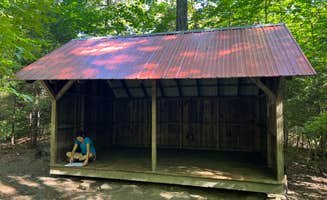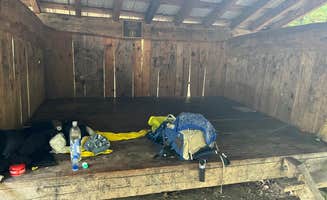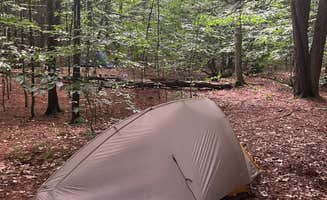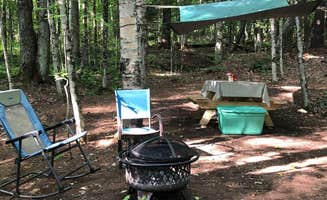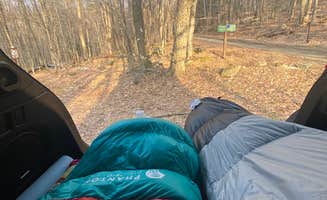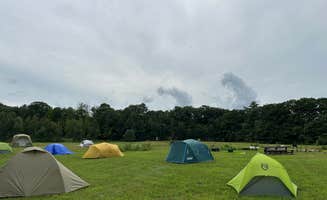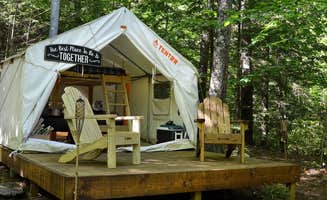Tent camping options near Windsor, Vermont center primarily on the Appalachian Trail corridor. The region encompasses portions of both Vermont and New Hampshire Green Mountain National Forests, with backcountry shelters positioned approximately every 8-10 miles along the trail. Most sites require hiking distances of 3-12 miles to access, with elevation changes between 500-1,500 feet depending on trailhead selection. Winter access becomes significantly limited from November through April due to snow conditions and unplowed forest roads.
What to do
Swimming in natural spots: At Stony Brook Backcountry Shelter, hikers can access a natural swimming hole during summer months. One visitor noted, "There was plenty of water at Stony Brook / Mink Brook a bit further northbound. I only explored a bit offtrail down the brook but found a decent swimming hole (could just barely submerge myself) to clean off a bit."
Wildlife observation: The forested terrain around tent sites supports deer, small mammals, and numerous bird species. Black bears are present throughout the region, necessitating proper food storage. Several shelters, including Stony Brook, provide bear boxes for food storage, which one camper highlighted: "There was also a bear box here, which I hadn't seen at other shelters along the AT in Vermont."
Summit hikes: From Cardigan Campsites in New Hampshire, visitors can tackle Mount Cardigan for panoramic views. A camper reported, "Great spot to spend the night before a climb of Mt. Cardigan! The climb is challenging but shouldn't take too long. Great fire tower views at the top too!"
What campers like
Multi-level shelters: The unique design of Happy Hill Backcountry Shelter offers separate sleeping areas. A hiker observed, "The shelter had a ground floor and a loft but each floor could maybe fit 4-5 people comfortably. The loft was nice since folks could decide to sleep up there while others were down below, either cooking, arriving, or departing."
Level tent sites: Winturri Shelter offers particularly good options for tent campers who prefer not to use the shelter structure. According to one visitor, "The shelter is on the larger side and could fit maybe 6-8 folks. There were lots of tent camping spots as you worked up the hill perpendicular to the shelter."
Scenic overlooks: Some shelters feature built-in viewing spots for meals or relaxation. At Moose Mountain Backcountry Shelter, a hiker appreciated that "The shelter did stand out with a bench overlooking a clearing in the brush with a view which was a great place to enjoy my freeze dried dinner."
What you should know
Water availability fluctuates: Water sources at most tent sites are seasonal and unreliable, especially in late summer. At Trapper John Shelter, a visitor reported, "There is a water source in the area but it did not have water when I visited (probably on account of the drought)."
New privies available: Recent improvements include upgraded toilet facilities at several backcountry sites. At Stony Brook, "The privvy looked brand new and was more spacious than most on the trail."
Limited cell coverage: Connectivity is minimal or non-existent at most of the best tent camping near Windsor, Vermont. At Michigan Brook Road Camping, a camper warned, "PLEASE NOTE: THIS LOCATION DOES NOT PROVIDE CELL PHONE SERVICE OR WIFI CONNECTION. However, if you walk to the end of upper Michigan Brook road you will have cell phone service."
Tips for camping with families
Consider site location: For families with younger children, backcountry shelters closest to trailheads minimize hiking distances. Thistle Hill offers more accessible options with shorter trail access from nearby roads.
Prepare for bathroom facilities: Privies vary significantly in quality and maintenance. One camper at Happy Hill noted, "The privvy was relatively new and in great shape," which can be an important consideration for families with children.
Day trips vs. overnight: Velvet Rocks Shelter provides a realistic backcountry experience without extended hiking. However, as one visitor observed, "This was a decent shelter to stop at along the AT, but I would not consider it a weekend destination."
Tips from RVers
Road conditions for access: While most backcountry sites prohibit vehicle access, Michigan Brook Road offers dispersed camping accessible by vehicle. A visitor cautioned, "Road goes in pretty far. Some parts are muddy and very rough. Higher clearance would be advised!!!"
Seasonal considerations: Winter conditions severely restrict vehicle access to the few drive-in sites available. An RVer at Michigan Brook shared, "I attempted to bring my car and was stuck overnight but was able to dig myself out the next morning."
Supply points: Stock up on necessities before heading to remote areas. Michigan Brook offers limited resources nearby: "If you walk to the end of upper Michigan Brook road you will have cell phone service and a gas station along with a United States Post Office as well as a general store which also serves as a restaurant."


